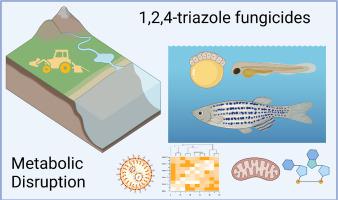Science of the Total Environment ( IF 8.2 ) Pub Date : 2021-10-23 , DOI: 10.1016/j.scitotenv.2021.151177 Tao Huang 1 , Haibo Jiang 2 , Yuanhui Zhao 2 , Jia He 3 , Hongguang Cheng 3 , Christopher J Martyniuk 4

|
In this critical review, we synthesize data from peer-reviewed literature reporting on triazole fungicide exposures in the zebrafish model. Based on their mode of action in plants (potent inhibitors of ergosterol synthesis), we focused attention on mechanisms related to cellular, lipid, and steroid metabolism. Evidence from several studies reveals that zebrafish exposed to triazoles present with impaired mitochondrial oxidative phosphorylation and oxidative stress, as well as dysregulation of lipid metabolism. Such metabolic disruptions are expected to underscore developmental delays, deformity, and aberrant locomotor activity and behaviors often observed following exposure. We begin by summarizing physiological and behavioral effects observed with triazole fungicide exposure in zebrafish. We then discuss mechanisms that may underlie adverse apical effects, focusing on mitochondrial bioenergetics and metabolism. Using computational approaches, we also identify novel biomarkers of triazole fungicide exposure. Extracting and analyzing data contained in the Comparative Toxicogenomics Database (CTD) revealed that transcriptional signatures responsive to different triazoles are related to metabolism of lipids and lipoproteins, biological oxidations, and fatty acid, triacylglycerol, and ketone body metabolism among other processes. Pathway and sub-network analysis identified several transcripts that are responsive in organisms exposed to triazole fungicides, several of which include lipid-related genes. Knowledge gaps and recommendations for future investigations include; (1) targeted metabolomics for metabolites in glycolysis, Krebs cycle, and the electron transport chain; (2) additional studies conducted at environmentally relevant concentrations to characterize the potential for endocrine disruption, given that studies point to altered cholesterol (precursor for steroid hormones), as well as altered estrogen receptor alpha and thyroid hormone expression; (3) studies into the potential role for lipid peroxidation and oxidation of lipid biomolecules as a mechanism of triazole-induced toxicity, given the strong evidence for oxidative damage in zebrafish following exposure to triazole fungicides.
中文翻译:

斑马鱼(斑马鱼)中 1,2,4-三唑类杀菌剂毒性的综合综述:线粒体和代谢的观点
在这篇批判性评论中,我们综合了来自同行评审文献报告的斑马鱼模型中三唑类杀菌剂暴露的数据。基于它们在植物中的作用方式(麦角甾醇合成的有效抑制剂),我们将注意力集中在与细胞、脂质和类固醇代谢相关的机制上。几项研究的证据表明,暴露于三唑类的斑马鱼存在线粒体氧化磷酸化和氧化应激受损,以及脂质代谢失调。预计这种代谢中断会突出发育迟缓、畸形和异常的运动活动以及暴露后经常观察到的行为。我们首先总结了在斑马鱼中暴露于三唑类杀菌剂时观察到的生理和行为影响。然后,我们讨论了可能导致不良顶端效应的机制,重点是线粒体生物能量学和新陈代谢。使用计算方法,我们还确定了三唑类杀菌剂暴露的新生物标志物。提取和分析比较毒物基因组学数据库 (CTD) 中包含的数据表明,对不同三唑类有反应的转录特征与脂质和脂蛋白的代谢、生物氧化以及脂肪酸、三酰基甘油和酮体代谢等过程有关。通路和子网络分析确定了几种对暴露于三唑类杀菌剂的生物体有反应的转录物,其中一些包括脂质相关基因。未来调查的知识差距和建议包括:(1) 糖酵解代谢物的靶向代谢组学,克雷布斯循环和电子传输链;(2) 鉴于研究表明胆固醇(类固醇激素的前体)发生改变,以及雌激素受体 α 和甲状腺激素的表达发生改变,因此在环境相关浓度下进行了额外的研究,以表征内分泌干扰的可能性;(3) 鉴于斑马鱼暴露于三唑类杀真菌剂后氧化损伤的有力证据,研究脂质过氧化和脂质生物分子氧化作为三唑诱导毒性机制的潜在作用。以及改变的雌激素受体α和甲状腺激素的表达;(3) 鉴于斑马鱼暴露于三唑类杀真菌剂后氧化损伤的有力证据,研究脂质过氧化和脂质生物分子氧化作为三唑诱导毒性机制的潜在作用。以及改变的雌激素受体α和甲状腺激素的表达;(3) 鉴于斑马鱼暴露于三唑类杀真菌剂后氧化损伤的有力证据,研究脂质过氧化和脂质生物分子氧化作为三唑诱导毒性机制的潜在作用。


















































 京公网安备 11010802027423号
京公网安备 11010802027423号